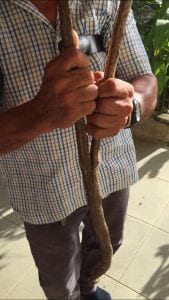
On July 5th, I traveled with the reforestation team to a town called Valleriquito (translated from Spanish it means “little rich valley”). While they were staking out a parcel (marking where the trees will be planted), My boss’ father (who was here to visit) and I, drove into the town to find Tonya, the Peace Corps volunteer. My goal was to meet with her, connect with some artisans, and find places to plant the artisanal plants I have growing in the office. As always when I travel out to el campo, I got more than I bargained for.
First we met Tonya at her host family’s house. As always, we were invited to sit on their porch and chat for awhile. When Tonya was explaining to her parents about what I was doing, her father enthusiastically collected some of his plants and handicrafts to show me. The first was Bejuco, a vine that grows in the mountains. It is harvested and then cut into smaller strips. Traditionally it is made into the baskets that campesinos (country men) wear on their backs to carry their supplies. He told me the different types of vines and which were the best for basket making. Bejuco Negrito is the softest vine, Bejuco Colorado is the most durable, and Bejuco Mariquita is somewhere in between. I asked him if I could collect some of the Bejuco to grow in the office, but he said the plant cannot be cultivated.
 Next, Tonya’s father brought us to his backyard where he had two Cogollo palms. Cogollo is the fiber the artisans used in the first and third workshop, and what many artisans use to make the Panamanian hats. He explained that just two palms of Cogollo will not be enough to make an entire hat. From each palm, only the middle branch can be harvested and used for fibers. In order to make hat, you would need many more trees. This is why much of the Cogollo that the artisans use today are bought from the store. The fibers come from a Cogollo plantation. As he was telling us about the plant, I was able to map it and get a video of him explaining how to harvest the palm.
Next, Tonya’s father brought us to his backyard where he had two Cogollo palms. Cogollo is the fiber the artisans used in the first and third workshop, and what many artisans use to make the Panamanian hats. He explained that just two palms of Cogollo will not be enough to make an entire hat. From each palm, only the middle branch can be harvested and used for fibers. In order to make hat, you would need many more trees. This is why much of the Cogollo that the artisans use today are bought from the store. The fibers come from a Cogollo plantation. As he was telling us about the plant, I was able to map it and get a video of him explaining how to harvest the palm.
He showed us a handmade pot that has been passed down in his family. It was used to filter water to make it clean. The water would seep through the clay and drip out the other side, providing clean water. While we were exploring the artistry of their home, Tonya’s mother was busy making a hat of Junco. It was the first time I had seen a traditional sombrero made of Junco rather than Cogollo.
 After learning from Tonya’s host father, we met with one of the teachers at the local school. We discussed the possibility of putting an artisanal garden in the school. She seemed interested and enthusiastic. We also talked with another artisan about the possibility of her and other artisans joining the Eco-Artisan and attending some of our workshops in Pedasi. This artisan was not as enthusiastic and seemed hesitant. Tonya later explained that many of the artisans do not like to leave town very often. It is difficult for them to get out.
After learning from Tonya’s host father, we met with one of the teachers at the local school. We discussed the possibility of putting an artisanal garden in the school. She seemed interested and enthusiastic. We also talked with another artisan about the possibility of her and other artisans joining the Eco-Artisan and attending some of our workshops in Pedasi. This artisan was not as enthusiastic and seemed hesitant. Tonya later explained that many of the artisans do not like to leave town very often. It is difficult for them to get out.
As always, I learned so much just by going out into el campo and pasear-ing, as the Peace Corps volunteers call it. Talking with the artisans is the best way to learn and prepare for my work. In the most rural towns, they are so knowledgeable in the different plants that can be used for medicinal and artisanal purposes. It is always worth it to go into el campo.
